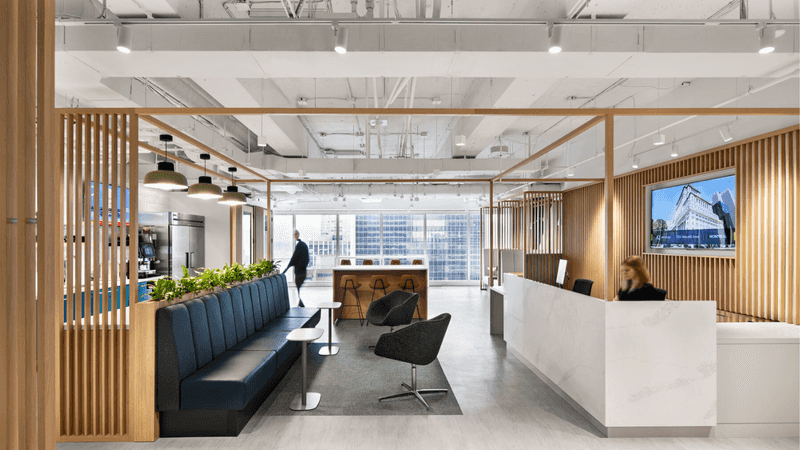
May 31, 2024
The Workspace Secret That Global Businesses Know and SMBs Are Missing
In this article, you’ll learn about how serviced office space can complement your traditional office offering to generate more profit and create the potential for longer-term tenancy.
“Grown-up companies get their own offices.”
For scaling companies, growing into your own office has long been seen as a signal of success. The act of signing a lease, building and branding your own workspace, and creating a headquarters for your team has historically been seen as a rite of passage.
But as innovative new workspace options gain mainstream traction and global organizations rethink their relationships with office space, this legacy ideology has been called into question.
As a result, we have identified an important office space insight that some of the world’s biggest organizations have picked up on—but that many SMBs seemingly aren’t yet savvy to.
Flexible office trends: small companies out, big companies in
For business leaders, office-related decisions are largely tethered to corporate psychology. At iQ Offices, we get to see behind the curtain, gaining direct insights into how these decisions are made.
In the last year alone, we’ve seen two interesting things happening:
- Many SMBs are departing flexible office spaces to pursue "cheap” show suites subleases, or short-term leases on their own standalone workspaces
- These same flexible office spaces being vacated by some SMBs are being backfilled by some of the world’s largest organizations
Interestingly, both types of businesses are seeking the same thing: cost savings. But each is making drastically different decisions in order to achieve this goal.
This begs the question:
Why would these massive organizations, with their abundant resources and limitless options, choose flexible workspaces over a cheap a traditional office lease or sublease—especially in a time where increased office vacancies in many markets have caused landlords to lower their lease rates?
We believe this indicates the existence of a misunderstanding among many SMBs about the true cost of running their own offices.
The catalysts driving today’s workspace trends
The idea that grown-up companies get their own office spaces is based on an antiquated way of thinking—one that was formulated when coworking spaces were suited solely for solopreneurs and one-, two-, or three-person teams.
But today, coworking spaces have evolved.
Many have expanded their offerings to provide flexible work environments suitable for teams of 25 to over 100.
So, we are now seeing global organizations leveraging flexible office spaces to provide their teams with desirable work environments in markets where they have smaller presences.
Simultaneously, traditional office buildings are experiencing increased vacancies in lower-class buildings. As a result, office landlords have become incentivized to offer lower rates and greater concessions that make their workspaces more compelling and attractive for SMBs.
The true cost of traditional office space
Given that both types of organizations want to save money on office space, why are so many global organizations moving toward flexible office space while SMBs are opting for traditional office space?
We believe large organizations understand the true costs of running an office space and want to avoid them.
This is one element of corporate psychology that factors into the office space equation: large organizations see simplicity as a value proposition. Rather than rerouting time and resources into securing office space and away from their core business, they opt for turnkey flexible work environments.
These organizations know that securing traditional office space might save them a few dollars, but they also understand the true costs of doing so.
Modern office users demand more than just workspace
The second facet of corporate psychology that factors into the office space equation is the lens through which organizations view their office environments.
Is having an office about having walls, desks, and chairs where employees must work during business hours? Or does it need to be something more today?
Let’s take one of the world’s biggest tech giants as an example.
The head office for this trillion-dollar business offers incredible amenities, such as:
- Cafes, restaurants, and chefs
- Health and wellness centers
- Dry cleaning services
- Outdoor spaces and sports facilities
- Entertainment and leisure
Why?
Because the company understands a few critical facts:
- Human capital is among its greatest assets
- Modern employees value an outstanding workplace experience
- Providing an office environment that adds value to their employees’ lives is essential for engagement, retention, and organizational success
They also understand that it’s virtually impossible to replicate the HQ experience in a standalone 5,000-square-foot workspace.
But they can replicate it in a flexible office environment.
Flexible office space: simplicity as a standard
Trillion-dollar organizations are embracing flexible office space because they know how difficult and expensive it is to create from scratch an office environment that meets their workplace experience standards.
They have learned from experience how costly and challenging it is to pull off.
So, they opt instead for premium, turnkey, customizable flexible workspaces where the amenities they want are already in place.
At iQ Offices, our core business is providing unparalleled flexible workspaces, and we’ve spent more than a decade perfecting our craft. We invite you to experience it for yourself—book a tour of your local iQ Offices location today.